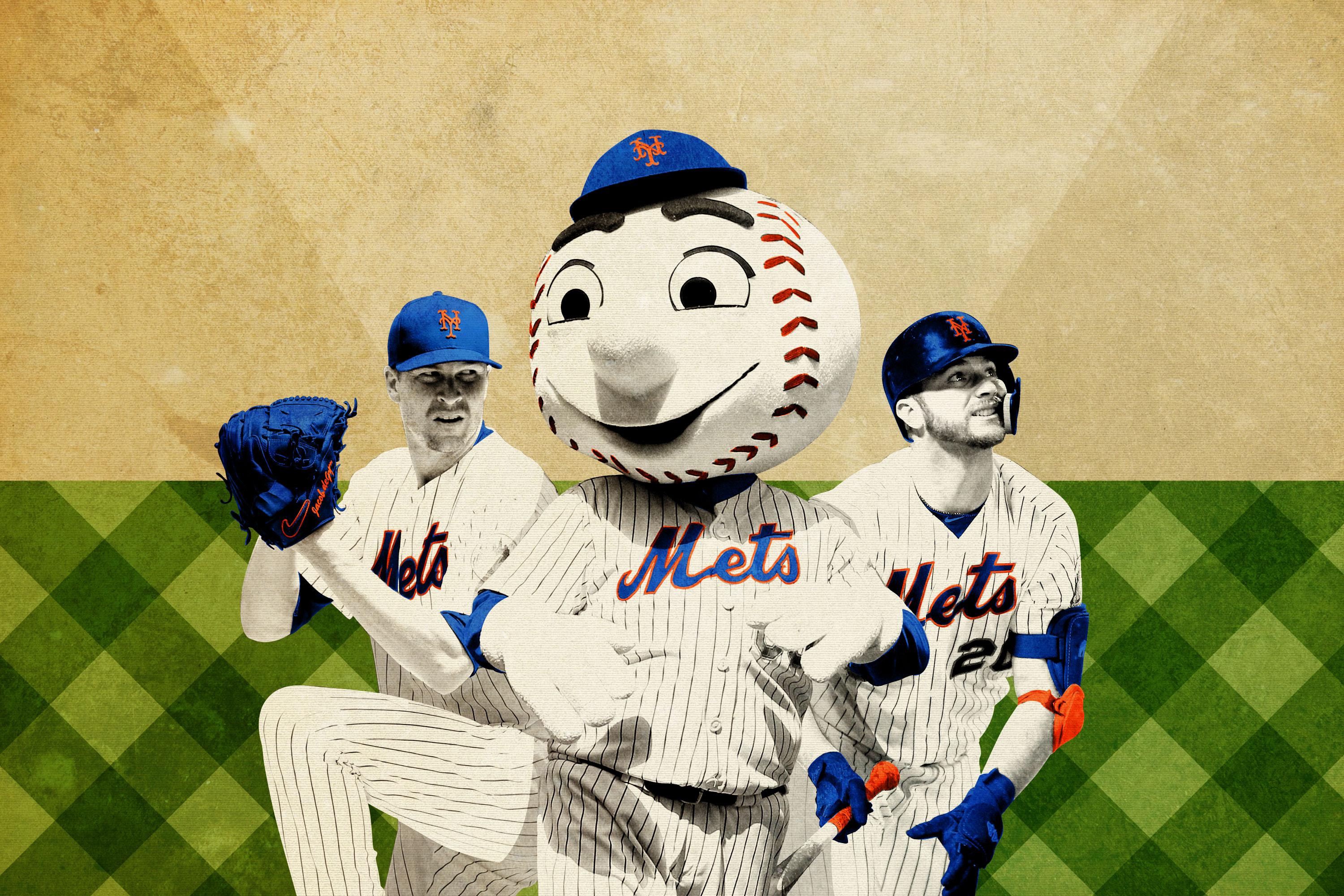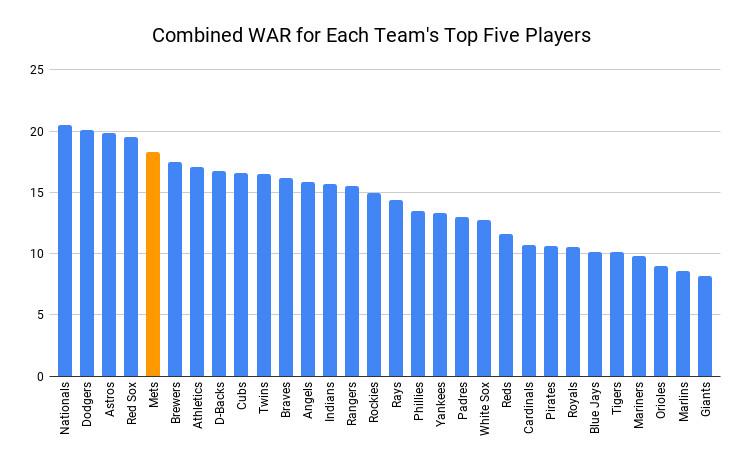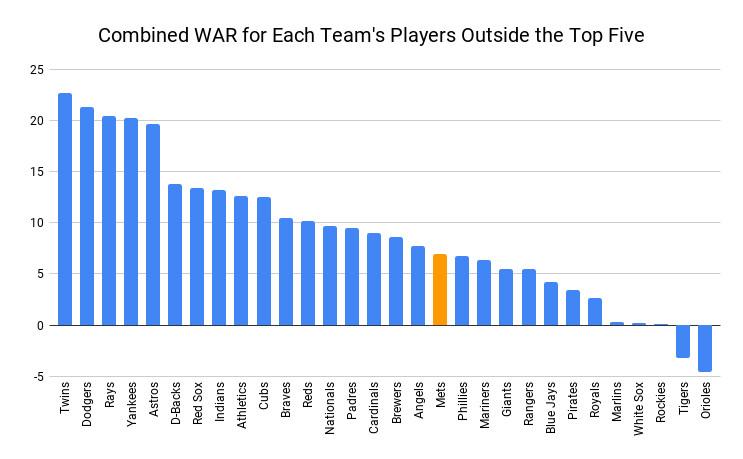
The funny thing is, the Mets were supposed to play—and win—this way all season long. After a busy offseason in which they added Robinson Canó, Wilson Ramos, Jed Lowrie, J.D. Davis, and Keon Broxton to bolster an overstuffed lineup, and Edwin Díaz, Jeurys Familia, and Justin Wilson to boost the bullpen, the Mets projected as a playoff contender on the strength of their power hitting, starting pitching, and lockdown relieving.
And then those strengths never coalesced, and the Mets stumbled through month after month of below-average play, coupled with above-average drama. The team’s most memorable moment of the first half was a confrontation between the press corps and the duo of manager Mickey Callaway and fifth starter Jason Vargas. Even Tim Tebow hit .163/.240/.255 in the minors before succumbing to a hand injury—the worst OPS for any Triple-A player with at least 200 plate appearances.
But after trading for Marcus Stroman at the trade deadline and not parting with any of their top players, the Mets are the hottest team in baseball. They’re 11-1 in their past 12 games, they’re over .500 for the first time since May 2, and they’re just 2.5 games back in the jumbled NL wild-card chase. Before the season began, FanGraphs’ projections gave the Mets a 40 percent chance of reaching the playoffs. Now, after all their ups and downs, the Mets’ playoff odds sit at 34 percent. It’s almost like the past four months of organizational chaos never happened.
The team’s recent run of success has elevated all their anticipated advantages. The offense is streaky but powerful, with rookie Pete Alonso (35 home runs, 147 wRC+) leading the way. In the second game of a doubleheader sweep against Miami on Monday, the Mets trailed 4-2 in the seventh inning—only for Davis, Michael Conforto, and Alonso all to bash solo homers in the frame to give the Mets a one-run win.
Beyond the sturdy top of the lineup, pitching has truly propelled the Mets over the past few weeks. Since they fell a season-high 11 games back of .500 in mid-July, the Mets are an MLB-best 17-5, with the majors’ best pitching staff over that span: 2.68 ERA, 3.33 FIP, and just a .220 batting average allowed.
After a slow start to the season, Jacob deGrom (2.77 ERA, 2.85 FIP) is back in contention for the Cy Young; he’s allowed more than two runs in a start just twice since April. Noah Syndergaard has a 2.88 ERA in his past 10 games, and has gone at least seven innings five starts in a row. Zack Wheeler returned from the injured list not to be traded, as was expected of the pitcher with an expiring contract, but to win two consecutive starts, across which he struck out 14 and didn’t issue a walk. Even Steven Matz joined the fun, tossing the first complete-game shutout of his career in late July.
Slotting Stroman in among that group gives New York the rotation with the best rest-of-season projection in baseball, per FanGraphs, and as good a reason as any to dream of a run to the wild-card game. Pending health, the Mets should be able to rely on, at the very least, competence on the mound each day, which is more than their rivals for the NL wild card can say. And even with Díaz still struggling to limit hard contact in the closer role, the likes of Seth Lugo (2.59 ERA, 2.94 FIP) have helped keep the bullpen afloat in support of those stellar starters.
That’s the good news. The bad is that it’s just as easy to frame the Mets’ outlook in a negative light. For one, the Mets’ surge has coincided with a soft spot on the schedule; their 11 wins in 12 games have come against the last-place Padres, last-place Pirates, third-place-and-out-of-contention White Sox, and last-place Marlins. It’s important to collect wins against poor opponents—imagine how much rosier the Phillies’ position would look if they were better than 6-7 against Miami—but the Mets are running out of such opportunities.
The average New York opponent the rest of the way is slightly better than .500, giving the Mets one of the more challenging end-of-season schedules in the National League. That matters because they haven’t yet displayed the ability to routinely defeat higher-caliber opposition. Here is the result of every Mets series against a team with a winning record this year:
Nationals: Won, 2-1
Nationals: Lost, 1-2
Twins: Split, 1-1
Braves: Split, 2-2
Phillies: Lost, 1-2
Cardinals: Lost, 1-2
Phillies: Won, 2-1
Brewers: Lost, 1-2
Brewers: Lost, 0-3
Nationals: Lost, 1-2
Nationals: Won, 4-0
Dodgers: Lost, 1-3
Yankees: Split, 1-1
Cardinals: Lost, 1-3
Braves: Lost, 1-2
Cubs: Split, 2-2
Phillies: Lost, 0-4
Braves: Lost, 1-2
Yankees: Split, 1-1
Phillies: Lost, 1-2
Twins: Won, 2-0
That’s four series wins—only one since May—alongside five splits and 12 losses. Overall, through Monday’s games, the Mets are 30-18 against teams with a losing record—the 10th-best mark in the majors. But against teams with a .500 record or better, the Mets are just 27-38, which ranks them 19th.
Even beyond the more challenging schedule, the Mets might face additional difficulties as the rest of the season plays out. Their league-worst defense hasn’t looked any better recently, for one. And injuries and attrition are starting to strain the roster’s resources. Look back on some of the offseason acquisitions, which were designed to give the Mets a surplus of useful batters to round out their lineup. Canó suffered through his worst season at the plate in more than a decade; he’s now out for the season after tearing his hamstring. Lowrie hasn’t played at all, thanks to a mysterious and ever-expanding list of injuries (now up to: knee sprain, hamstring strain, and calf strain all at once). Broxton didn’t hit for two months and then was traded.
The down-roster difficulties haven’t stressed the top too much; New York still glows with stars. By FanGraphs WAR, the top five Mets—deGrom, Alonso, Jeff McNeil, Syndergaard, and Wheeler—have been worth a combined 18.3 WAR this season. That’s the fifth-highest total for a top five. (Pitcher hitting is excluded from this analysis, so NL teams with feeble-hitting pitchers aren’t penalized.)

After those first five, though, all the other Mets have combined for just 7.0 WAR; that ranks 18th, which is the lowest “everyone else” placement for a team in the top 10 in “star power” rank.

In the lineup specifically, this discrepancy manifests with an unfit cast of bench bats and injury replacements. Of the nine Mets with the most plate appearances, seven have been better than average at the plate, and Ramos is near average (and certainly better than the baseline for catchers). Canó is thus the only offensive disappointment among the regulars. But among the other 10 nonpitcher Mets who have batted this year, the only one with a wRC+ higher than 88—in a stat in which 100 is average—is Rajai Davis, who went 2-for-7 with a home run in May before being designated for assignment. The current 25-man roster includes Adeiny Hechavarría (72 wRC+), Juan Lagares (42), Tomás Nido (42), Luis Guillorme (-7), and Aaron Altherr (-8).
With Canó out for the season, and valuable backup Dominic Smith out until at least the middle of September with a foot injury, Callaway is forced into either playing his best players every day, some out of position, or handing in a tremendously imbalanced lineup card. On Tuesday, the lineup against the Marlins featured Guillorme hitting sixth, Hechavarría seventh, Lagares eighth, and pitcher Wheeler ninth—essentially giving the opposition free outs for half the game. That might not matter against the Marlins, but it will against most other teams on the Mets’ remaining schedule.
In one sense, then, the Mets are chaotic and unpredictable and largely imaginative with their bureaucratic mishegas. But on the other, they’re playing exactly as expected, conforming to both preseason predictions and their own in-season underlying numbers. Through Monday, they had an actual record of 57-56, a Pythagorean record (which estimates a team’s “deserved” record by runs scored and allowed) of 57-56, and a BaseRuns record (which estimates a team’s “deserved” record by the results of all plate appearances) of 57-56. They’re just sort of average, with some obvious strengths and other obvious weaknesses, and hot and cold streaks that cancel out and push them ever to the middle.
Luckily for the Mets, that description applies to a half-dozen other NL teams, all of which look sort of average, too, all of which feature their own obvious weaknesses, and all of which go through their own cold streaks—all of which, like the Mets, are aiming for something like 86 wins and a backdoor playoff berth.
The Nationals and Phillies currently lead the wild-card standings, but those graphs show that Washington suffers from the same roster imbalance that the Mets do, plus one of their stars—Max Scherzer—is currently hurt; Philadelphia has been outscored this season, so the Phillies are somehow overperforming their peripherals but still struggling to create any distance. The Cardinals and Brewers both have drastic rotation concerns; the Diamondbacks just traded their best pitcher; the Giants are fading as they enter a tougher portion of their schedule, having gone 4-7 in their past 11 games after a 17-3 stretch convinced them they could still compete.
Placed against that backdrop, New York’s hope is perfectly reasonable, and its roster doesn’t look so flawed. Every NL team besides the Dodgers has problems, so what does it matter how the Mets have arrived at this point, squarely back in the race? That they’re back in at all is what matters. At least some of these teams must reach the playoffs, after all.
Stats current through Monday.

